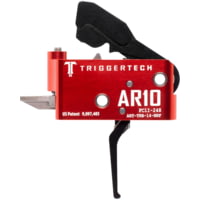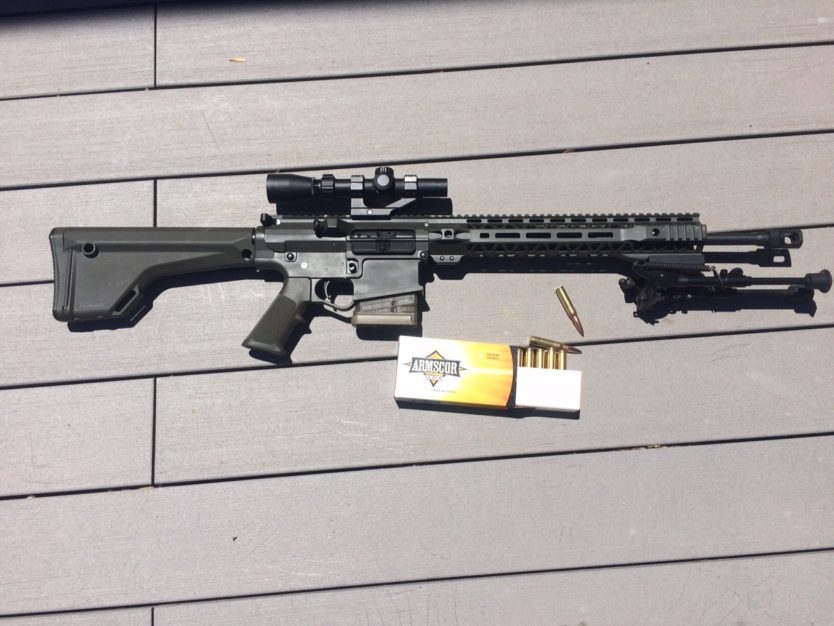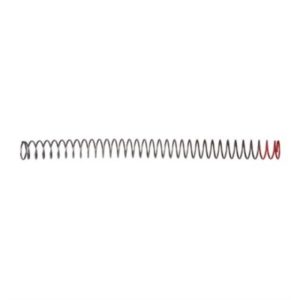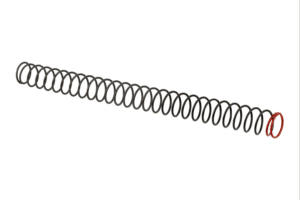Back in the 1950’s, Eugene Stoner designed the first modern modular rifle, the AR-10. The gas impingement operating system and buffer system offers a potential optimization that has yet to be completely fulfilled. Imitation being the most sincere form of flattery, since then a lot of people made their own versions of Stoner’s masterpiece.
Today, there are a lot of great .308 ARs out there. Whether you got a new gun in a box or finished an 80% lower, there are some things you need to know. The guys that make parts for .308 AR rifles like standards so much, they created a bunch of them. Not only do you have to get parts that fit, you need a rifle that runs.
Guide to Building a 308 AR Rifle
The availability of quality matched receivers from companies like Tridentis and the popularity of 80% receivers have got a lot of people putting together do-it-yourself “Franken” ARs. I love the educational aspects of this and the amount of new freedom created. The problem is that without a basic understanding of how the rifle functions, you could end up with an expensive doorstop.
The AR is great in all its manifestations, but to be fun, guns have to shoot every time. If we understand how the combination of components affects function, we can get that great reliability that made us love ARs, increase the service life and reduce felt recoil.
There are three basic patterns of .308 ARs:
- SR-25
- Armalite
- DPMS.
To make this even more confusing, there are variations on these patterns which combine the features. Even proprietary receivers like the LWRC REPR .308 rifles still has some common parts. For the same reason that IBM clones grew to rule the computer market, most .308 ARs use DPMS parts and dimensions.
Learn From My Mistakes
Pictured is my home assembled DPMS pattern .308 AR. I made a few mistakes and bought some parts I couldn’t use because of compatibility. Learn from my mistakes. Buying parts and then checking compatibility is expensive. 308AR.com has very helpful information on 308 AR Compatibility taking the guesswork out of internet shopping.
The things I did right?
Faxon barrel, Aero Precision Upper and rail, Magpul stock, and Triggertech Trigger.

I bought an SR-25 back before they were cool. At the time, the 24″ barrel and the slick synthetic float tube were awesome, but as we entered the second decade of a new century, I wanted the best AR 10 barrel and some rails. A guy locally had a 16″ LMT barrel for sale, I bought it. When I went to find an SR-25 upper, I found out that Knight’s Armament won’t sell them and that an LMT barrel won’t fit anyway. I a kind of blind luck that disproportionally finds Green Berets, I ran into another guy selling an LMT upper, then found out that an LMT Modular Weapon System upper fits my SR-25 lower. Problem solved, or so I thought. The gun fired and had good accuracy (Thanks LMT) but it would only fire the first round and refuse to chamber a second 50% of the time even with new Lancer mags. The SR-25 buffer is a very lightweight nylon plug. It was not doing the job with the LMT upper.

Triggertech AR-10 Diamond Trigger— 3 models from: OpticsPlanet, Inc
The middle of the story is everything I had to learn to write this article. The happy ending is that I got ten glorious ounces of AR10R-XH buffer. Paired with the “Green” full-length spring from Sprinco, I got complete reliability and less felt recoil. Shooting the same gun, first with the OEM buffer and then the AR-10R-XH buffer at 200 yards on a 8″ X 8″ steel plate, my split times were reduced by 25% due to faster recovery from recoil. Problem identified and solved. Hopefully, you are smarter than I am, and you are reading this BEFORE you build a gun.
The AR-10 was purpose-built for military 7.62mm M-80 ball ammo from a 20.8-inch barrel. The buffer and spring were designed for that combination. When the AR-15 was designed in 5.56, the buffer tube was left in the same dimensions but the buffer length and weight were changed. The AR-10 buffer was 5 3/16″ (5.188″) long and weighed 5.4 ounces. The AR-15 buffer is 5 7/8″ (5.875″) long and weighs 5.2 ounces.
I recommend the use of high-quality factory ammunition like Armscor .308. You might get a deal on surplus ammo, but don’t blame your gun if it doesn’t cycle. You can tune a gun for weak ammo, but you better re-tune it if you shoot the good stuff.
If you pick a buffer that is too long or a buffer tube that is too short, your gun may pass a manual function check, but hand cycling doesn’t replicate the forces acting on the rifle during firing. The bolt carrier may eject a cartridge and lock on the back of the magazine follower instead of the bolt catch. The bolt will release properly when you press the bolt catch. This is confusing and irritating when you go to the range.
The first round will load and fire normally, but after ejecting, the bolt will not load a second round from the magazine. The bolt will be forward with the chamber empty. The bolt doesn’t move far enough back against the buffer to strip a new round from the magazine and chamber it. This what happened to me intermittently until I changed my buffer and spring.
Upgrading Your Completed AR-10?
If you buy a complete gun, chances are the manufacturer did the homework for you. Here are a couple of parts you can upgrade:
- suppressor
- changing stock
- AR 10 Upper Receivers
- AR 10 Lowers
- use non-standard ammo
Find the Correct Buffer and Spring
Finding the correct buffer and spring will result in a high-functioning rifle with extended service life.
You can choose a lighter buffer to reduce lock time and increase cyclic rate. A heavier buffer will keep the rifle in battery slightly longer reducing bounce and transfer more inertia to the bolt providing reliable chambering when dirty.
Adjusting buffer weights can accommodate different ammunition or reducing the recoil impulse. A heavier spring with a properly tuned gas system can often yield a faster, lighter impulse that feels almost like an AR-15, very easy to clear or load.
Sprinco AR-10 Buffers
Springco has designed a new series of ultra-high density co-polymer spacers. They will permit the use of the many weighted carbine buffers and Sprinco “Red’ and “Orange” springs in your .308 rifle length extension tubes to provide many different combinations to match your particular applications.
Most manufacturers use Delrin for their spacers, which will eventually deform. Aluminum spacers are louder and cost more. Sprinco’s proprietary co-polymer retains energy absorption properties yet is tough enough to maintain shape through extensive use. One spacer will net out the effective depth of the AR-10 pattern receiver extension (Armalite, Noveske, LMT, etc.) so you can use standard length 3.25″ carbine buffers.
There is a model for DPMS pattern .308 carbines using the M4 extension tube and 2.5″ carbine buffers. They also have a couple of spacers for the VLTOR A5 which will allow the use of hydraulic carbine buffers or regular 3.25″ carbine buffers.
Sprinco AR-10 Red Buffer Spring
The “Red” spring can only be used in AR-10 pattern extension tubes. This was their first AR buffer spring solution. The RED spring is appropriate for moderately gassed .308 / 6.5 CM / .260 Rem heavier caliber carbine platforms using AR-10 / SR-25 Pattern
Sprinco AR-10 Orange Extra Power Carbine Buffer Spring
The “Orange” spring may be used in either pattern rifle. This spring is recommended with LMT’s (which are pretty highly gassed), and other builds when suppressed. This gives you a broad choice of weights Along with these two offerings,
Another option is the JP Custom Silent Captured Spring. This fully adjustable combination buffer and spring assembly eliminate the friction of standard buffer components resulting in slick and quiet operation. The alternate spring pack for the JPSCS-10 (pack of 3 different spring weights) spring allows custom tuning, and both rifle and carbine length systems.
Experimentation will allow custom tuning of any given rifle. Original manufacturers .308 AR springs and buffers spring should offer good performance over a wide range of configurations, but if you have any reliability issues, why not check a different buffer weight or spring? This alone can yield truly optimized performance, particularly for rifles without an adjustable gas block.
In selecting a spring for your rifle, install a heavier spring if you feel the buffer head fully compress and bottom out while firing the weapon. If the bolt carrier will not lock back reliably on the last round fired, even when completely gassed (in the case of an adjustable gas block), select a lighter spring.
Get this right, and your great-grandkids can be shooting giant mutant rats from post-apocalyptic radioactive rubble with these rifles. Got a carbine?




